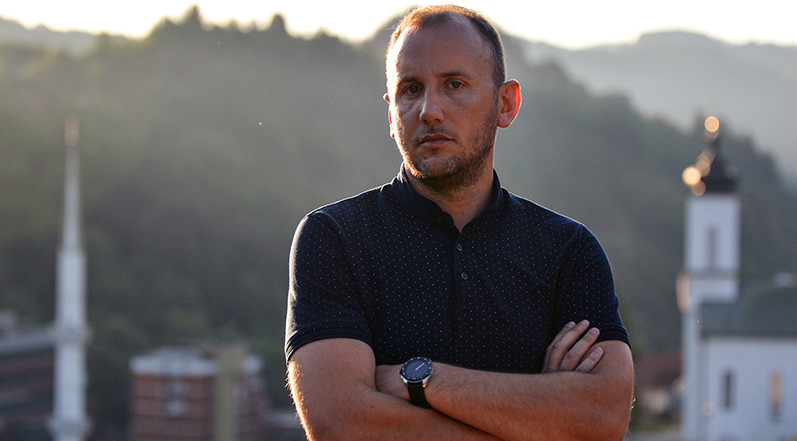Have you ever passed by Prizren on the Sana, a mysterious location of unusual beauty? As you look towards the canyon of the Sana River, you may wonder who built the architectural complex on top of that hard-to-reach cliff, several hundred meters above the river’s flow.
What secrets lie behind the walls of this mysterious structure? Answers to these questions have been revealed by an archaeological team from the Museum of Republika Srpska, led by archaeologist and museum advisor Goran Simonović.
They say it is the remains of a luxurious residence or a smaller palace!
While local tradition claims that a town belonging to the Black Queen was once located there, who left with horses shod upside down, loaded with immense treasures to escape the Turkish conquerors, archaeologists are more inclined to believe that the person who built this smaller palace in Prizren should be sought among the nobility that resided in the town of Ključ and governed the Banjica district, one of the districts of Donji Kraj, a region of medieval Bosnia. However, questions about the original purpose of the complex and who built it will remain open until the excavations are complete.
What has been found in Prizren?
Simonović and his team resumed archaeological research in mid-October, which has been ongoing for nine seasons, discovering that the walls of the smaller late medieval complex were constructed in a manner characteristic of that period. “The walls are made of broken and crushed stone, bound with lime mortar, laid in uneven horizontal rows with round openings, and there are traces of wooden scaffolding supports,” explains Simonović.

In the central section of the complex, they found a building that included a hall and a cellar. “In the construction debris, in 2013, decorated parts of the architecture of this enigmatic complex sparkled in archaeological sieves. There were parts of window frames or doorjambs made of soft sandstone, decorated with a motif of twisted ribbons and carved geometric designs. The luxurious nature of some of these finds suggests that the original purpose of the complex in Prizren might have been residential,” adds Simonović.
Among the layers of earth that have covered the ruins of the complex for over 500 years, archaeologists discovered another layer with significant content. These finds, including parts of late medieval weapons, pottery, animal bones, pieces of millstones, glass vessels, horse equipment, a flute, a fishing hook, and construction clamps, provided crucial information about the mysterious past of this place.
The destruction of the complex
Investigating further, the archaeologists concluded that the complex was most likely destroyed in 1463 during the first fall of Bosnia to the Turks. “Shortly thereafter, a military garrison occupied the complex, which adapted, partially removed, and demolished the remaining structures for communication purposes,” explains Simonović. He adds that all indications point to the observation tower at Prizren functioning as part of a chain of fortifications and observation posts belonging to the Jajačka Banovina, a strategic zone toward the Turkish Empire, formed after the Hungarian state seized parts of the former Bosnian kingdom from the Turks. The military garrison likely left the site by the end of the 15th century, after which the place fell into neglect and was left to the ravages of time.
Did the Illyrians also reside here?
In their exploration of Prizren, the archaeologists, with the help of local residents, discovered remains of a fortified prehistoric settlement on top, a hillfort type settlement, from which those who discarded broken pots on the summit of the cliff came. “The discovery of several fragments of prehistoric pots, found at the very beginning of the research by sheer chance on the surface of the site, testifies that many have ascended to this rock above the turbulent and canyon-encased Sana long before the medieval builders arrived. It is unusual, but these unremarkable, discarded pieces of broken earthenware immediately immerse us in the labyrinths of history of unfathomable depth, taking us back to an ancient time, to the Iron Age, somewhere in the first millennium BC, when members of a local Illyrian tribe sought refuge from enemies or natural disasters by moving themselves and their loved ones to the highest peak of the Prizren hill, laying the foundations for what would later become a town with a rich history,” writes Simonović.
The future of Prizren on the Sana
This year, the research will focus on excavating the southern section, which is currently the least explored. Simonović notes that systematic archaeological research at Prizren on the Sana will provide a solid database that will significantly contribute to the study of the medieval heritage of Republika Srpska and Bosnia and Herzegovina. The discovered artifacts could serve as the basis for a future local museum in Mrkonjić Grad.
After the research is completed, a monograph about the site will be created to accompany the final exhibition. Archaeologists are confident that Prizren on the Sana has a bright future, with a reconstructed complex, museum displays, and attractive content that will draw visitors.
Systematic archaeological research of this site has been ongoing since 2011. It is organized by the Museum of Republika Srpska, with financial support from the Municipality of Mrkonjić Grad and the Ministry of Education and Culture of Republika Srpska.
Source: See Srpska









